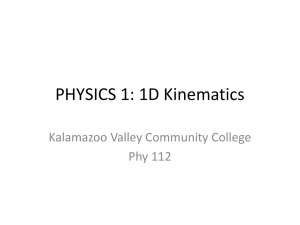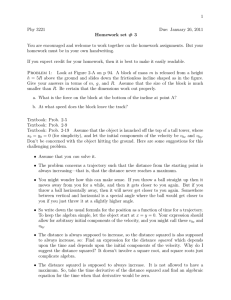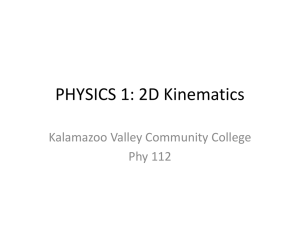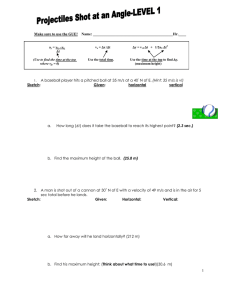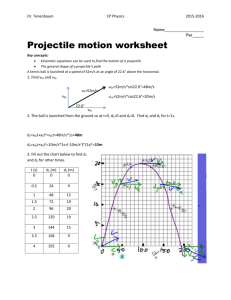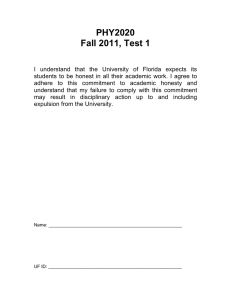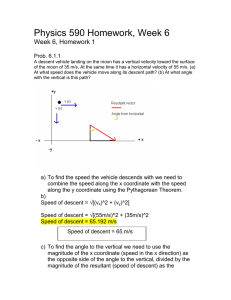Physics I – Exam 1 – Spring 2007 Answer Key
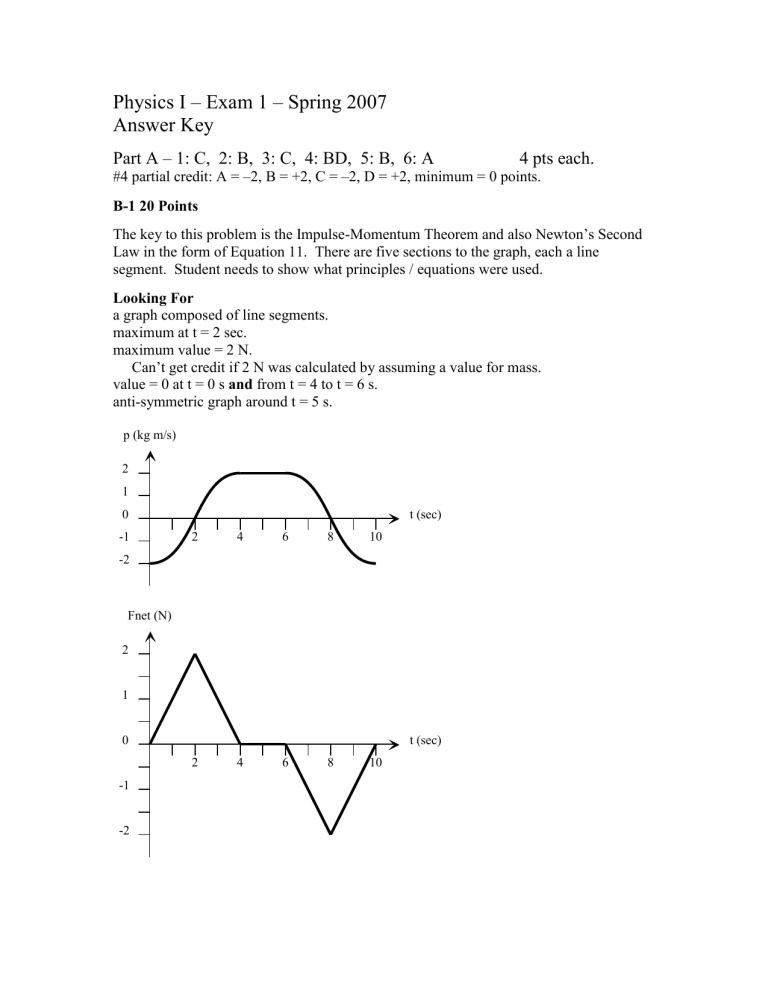
2
1
0
-1
-2
Physics I – Exam 1 – Spring 2007
Answer Key
Part A – 1: C, 2: B, 3: C, 4: BD, 5: B, 6: A 4 pts each.
#4 partial credit: A = –2, B = +2, C = –2, D = +2, minimum = 0 points.
B-1 20 Points
The key to this problem is the Impulse-Momentum Theorem and also Newton’s Second
Law in the form of Equation 11. There are five sections to the graph, each a line segment. Student needs to show what principles / equations were used.
Looking For a graph composed of line segments. maximum at t = 2 sec. maximum value = 2 N.
Can’t get credit if 2 N was calculated by assuming a value for mass. value = 0 at t = 0 s and from t = 4 to t = 6 s. anti-symmetric graph around t = 5 s. p (kg m/s)
2 4 6 8 10 t (sec)
1
0
2
Fnet (N)
-1
-2
2 4 6 8 10 t (sec)
Part C
Must show work to receive credit, particularly what principles / equations were used.
C-1 24 Points
This problem uses equations 1-5 for X and Y motions separately, using time to connect the two separate motions. Variations in equations used are possible. vy = 0 at the greatest height, which is 10 seconds after firing. Use equation 1:
0 = v0y + a y
t = v0y + (–9.8)(10) → v0y = 98 m/s.
Use equation 3 to find how high at maximum height: yf = y0 + ½ (v0y+vfy) t = 1470 + ½ (98+0)(10) = 1470 + 490 = 1960 m.
Use equation 2 from the starting point of maximum height to find how long to drop : yf = y0 + v0y
t + ½ a y
t
2
= 0 = 1960 + 0
t + (–4.9)
t
2
→
t = 20 s after max height.
Total time of flight = 10+20 = 30s.
Use equation 2 again for the X direction, knowing a x
= 0:
2940 = 0 + v0x (30) → v0x = 98 m/s.
Looking For equation(s) of motion separately in X and Y directions. knowing a y
= –g and a x
= 0. any correct method of finding v0y. trying to find total time of flight. any correct method for total time of flight. correct relationship horizontal d = v0x × time of flight. correct value of v0x. correct value of v0y.
C-2 32 points
C-2-1: Impulse-Momentum Theorem: The change of momentum of an object over a time interval is equal to the net force on the object integrated over the same time interval, which is defined as the impulse (J vector) on the object. This is equation 12.
C-2-2: Conservation of Momentum applies to this problem because there are no external forces on the system. I picked the two objects as my system because they are the two objects interacting in the problem and if they are the system, there are no external forces.
C-2-3: Using Conservation of Momentum: m vAx + m vBx = (m+m) vfx → (0.5)(16)+(0.5)(0) = (0.5+0.5)vfx → vfx = 8 m/s. m vAy + m vBy = (m+m) vfy → (0.5)(0)+(0.5)(12) = (0.5+0.5)vfy → vfy = 6 m/s.
For Object A:
px = m (vfx – vAx) = (0.5)(8–16) = –4 kg m/s.
py = m (vfy – vAy) = (0.5)(6–0) = +3 kg m/s.
Using the Impulse-Momentum Theorem:
J
4 iˆ
3 jˆ N-s
Looking For
C-2-1: correct definition of Impulse-Momentum Theorem. identifying the correct equation (12).
C-2-2: relating Conservation of Momentum to no external forces. any reasonable explanation of picking both objects as the system.
C-2-3: separating X and Y directions. correct equation in X direction (both objects having same vfx). correct equation in Y direction (both objects having same vfy). correct vfx = 8 m/s. correct vfy = 6 m/s. setting J =
p. correct value of Jx = –4 N-s. correct value of Jy = +3 N-s.
